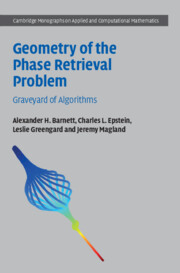Book contents
- Frontmatter
- Contents
- Preface
- Acknowledgments
- 1 Introduction
- Part I Theoretical Foundations
- Part II Analysis of Algorithms for Phase Retrieval
- 6 Introduction to Part II
- 7 Algorithms for Phase Retrieval
- 8 The Discrete, Classical, Phase Retrieval Problem
- 9 Phase Retrieval with the Nonnegativity Constraint
- 10 Asymptotics of Hybrid Iterative Maps
- Part III Further Properties of Hybrid Iterative Algorithms and Suggestions for Improvement
- References
- Index
7 - Algorithms for Phase Retrieval
from Part II - Analysis of Algorithms for Phase Retrieval
Published online by Cambridge University Press: 21 April 2022
- Frontmatter
- Contents
- Preface
- Acknowledgments
- 1 Introduction
- Part I Theoretical Foundations
- Part II Analysis of Algorithms for Phase Retrieval
- 6 Introduction to Part II
- 7 Algorithms for Phase Retrieval
- 8 The Discrete, Classical, Phase Retrieval Problem
- 9 Phase Retrieval with the Nonnegativity Constraint
- 10 Asymptotics of Hybrid Iterative Maps
- Part III Further Properties of Hybrid Iterative Algorithms and Suggestions for Improvement
- References
- Index
Summary
In this chapter we introduce the basic types of algorithms used in to find intersections of sets in Euclidean space. Among other things we analyze their behavior on pairs of linear subspaces. This analysis shows that, when two linear subspaces meet at a very shallow angle, the known algorithms can be expected to converge very slowly. The linear case then allows us to analyze the behavior of these algorithms on nonlinear subspaces.We begin with the classical alternating projection algorithm, and then consider algorithms based on hybrid iterative maps, which are motivated by the HIO algorithms introduced by Fienup. We also include a brief analysis of the RAAR algorithm. We introduce nonorthogonal splitting of the ambient space, which have proved very useful for analyzing algorithms of this general type. In a final section we outline a new, noniterative method for phase retrieval that uses the Hilbert transform to directly. This approach requires a holographic modification to the standard experimental protocol, which we describe. The chapter closes with an appendix relating alternating projection to gradient flows.
- Type
- Chapter
- Information
- Geometry of the Phase Retrieval ProblemGraveyard of Algorithms, pp. 115 - 146Publisher: Cambridge University PressPrint publication year: 2022

